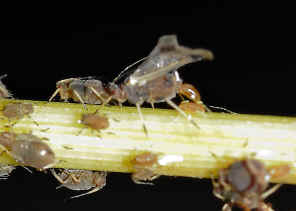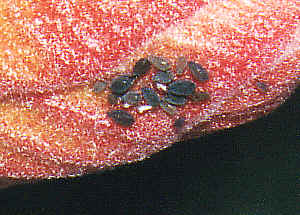|
| | Aphids - Family Aphididae
-
This page contains pictures and information about Aphids in Family Aphididae that we
found in the Brisbane area, Queensland, Australia.
-
 - Winged adults
-
- Aphids are small to very small in size. They are soft body and usually
wingless. There are the winged form adults with very thin membranous wings. Usually
their body is in pear-shaped. Most species have a pair of
posterior at the abdomen. The antenna are medium length with 5 or 6
segments.
-
- Like most other bugs, aphids are sap-sucking insects. Unless aphid colonies are
allowed to grow into very large size, their feeding activity causes little damage. The real problem is the aphids
could carry plants virus
which may infected plants.
-



- Give birth live
Attended by
ants
Aphid predator
-
- Aphids are success because of their high fecundity. They out-number the
parasites and predators by high reproductive rate.
-
- They have complex life cycle and different between species. In general
there are many generations per year but they are sexually reproduce (females
mate with males and lay eggs) only once annually, usually during autumn
season. The fertilized egg is the over-wintering stage. The other generations
within the year are all females and they reproduce without mating. Female aphids give birth live young
on the same plants and form colonies. Basically aphids are genetically identical
in a colony. A female in general produces 100 nymphs in 30 days. Each new born takes
about a week to become adult and start reproduction. Nymphs progress through five nymphal instars.
They switch to sexually reproduce when the favorites conditions disappear,
such as lower temperature, shorter day-light period and/or reduced in host
plant quality.
-
- In most
of the time adult aphids are wingless. Sometimes, usually in spring and autumn,
winged aphids appear and they move to new plants to start new colony.
-
- Aphid populations are growing rapidly during the spring season. Reproduction
is high in spring because they get enough food from the growing plant.
After the spring season, predators and parasitoids start to grow and reach a
level to suppress the aphids.
-
-
- Milkweed Aphid, Oleander Aphid
 
 - Aphis nerii, body length 3mm
- There was a site in Macgregor, Brisbane which were a lot of milkweeds. We often
visited there to look for Wanderer
Butterflies. On those milkweeds, there were usually the yellow aphids. There
were not many activates
except all the aphids were sucking the juice from the plant. The aphids were bright yellow in colour with black legs. Sometimes we
saw lady-beetle
hunting among those aphids. More information please click here.
-
-
- Cowpea Aphid
   - Aphis craccivora, body length 2mm
- Sometimes on the hibiscus plants in our backyard, we can find this aphids.
They are grayish-black in colour. They seem not doing much harm to our plants
although they are the famous pest. We have more information on this page.
-
-
- Rose Aphid
   - Macrosiphum rosae, body length 2mm
- This aphids are common in Brisbane Garden. They are brownish-pink in
colour. Stay on every new stems and flower buds. More information and
pictures please click here.
-
-
- Black Citrus Aphid
   - Toxoptera citricida, body length 2mm
- Those aphids are black or dark brown in colour. They development colonies
on young growing tips of the citrus trees. They are common in all citrus
growing area. The first picture shows an ant attending them for the honeydew that
the aphids extracted. Details please check this Black Citrus
Aphid page.
-
-
- Unknown Yellow Aphid
  - ? sp., Body length 2mm
- The aphids suck the
plant juice. Within the juice, there are water and sugar more than the aphids' need. They are excreted as honeydew.
Those ants are attending the aphids for the honeydew.
-
 

-
- Reference:
- 1. Insects
of Australia - CSIRO, Division of Entomology, Melbourne University
Press, 2nd Edition 1991, p 453.
- 2. Family APHIDIDAE - Australian Biological Resources Study, Australian Faunal Directory.
-
- Back to Top
-
- [ Up ] [ Psyllidae ] [ Aphididae ] [ Margarodidae ] [ Pseudococcidae ] [ Eriococcidae ] [ Dactylopiidae ] [ Coccidae ] [ Diaspididae ] [ Other Soft Bug families ] [ Unknown Galls ]
| |
|





















